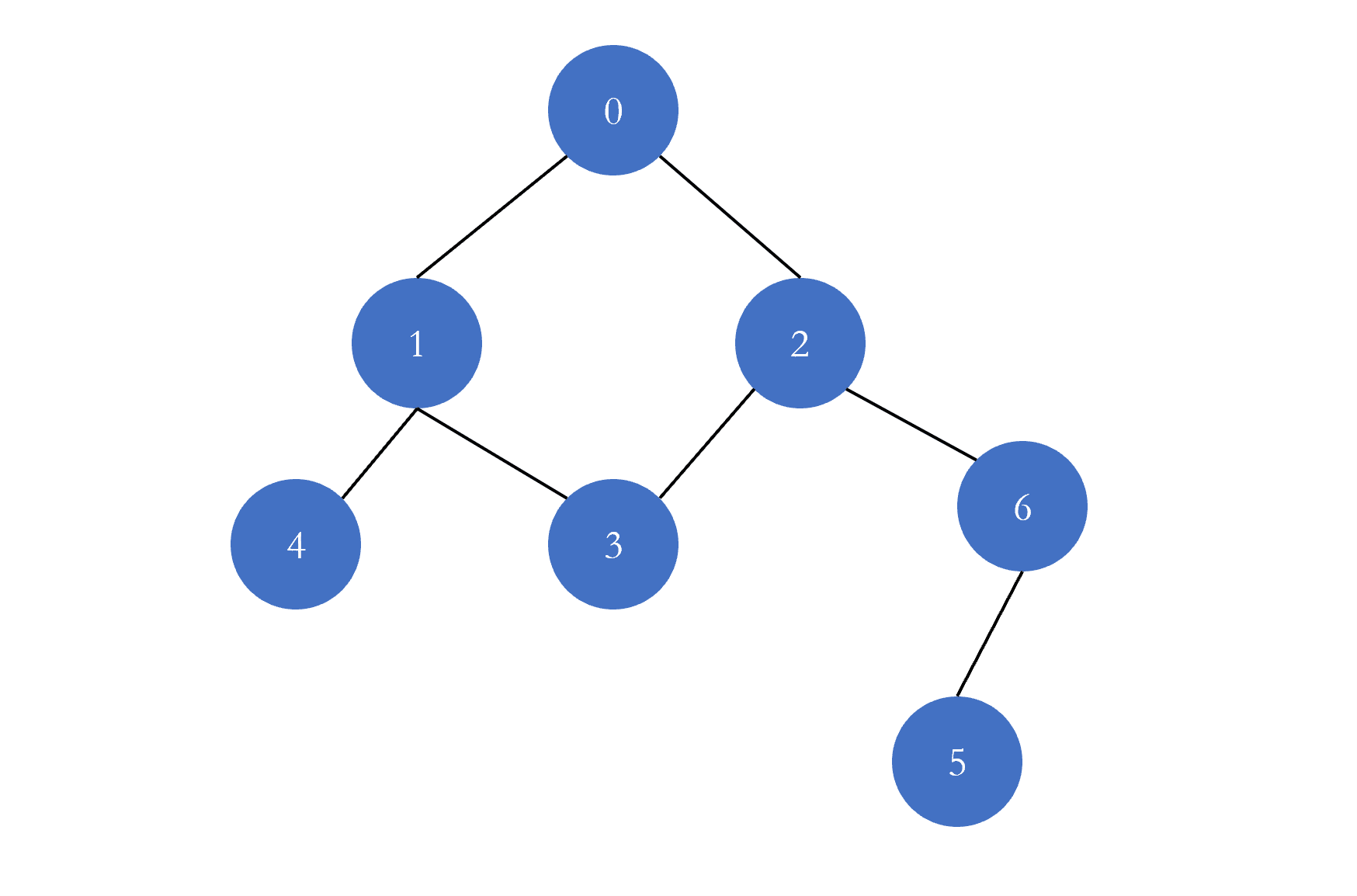树的层序遍历 树的层序遍历是指一层一层的遍历树的节点,它的实现是借助于队列进行实现的:
每一次从队列的头部取出元素进行遍历,然后将该元素的左右孩子添加进队列,以此往复,直至队列为空,遍历结束。
import java.util.LinkedList;import java.util.Queue;public class BinaryTree private class Node private Node left; private Node right; private int value; public Node (int value) this .value = value; } } private Node root; public BinaryTree (int value) root = new Node(value); } public void levelOrder () if (root == null ) { return ; } Queue<Node> queue = new LinkedList<>(); queue.add(root); while (!queue.isEmpty()) { Node node = queue.remove(); if (node.left != null ) { queue.add(node.left); } if (node.right != null ) { queue.add(node.right); } System.out.println(node.value); } } }
图的广度遍历 图的广度优先遍历与树的层序遍历相似,所谓的广度是指尽可能的遍历所有 的相邻元素
广度优先遍历的实现同树的层序遍历类似,也是借助于队列这种数据结构,每次从队列的头部取出节点进行遍历,然后将该节点的所有相邻节点添加进队列,但是需要注意的是,因为图有可能发生重复遍历,所以需要使用visited 标记已遍历的节点;另外还需要考虑到有多个联通分量的情况,与深度优先遍历的写法类似
import java.util.ArrayList;import java.util.LinkedList;import java.util.Queue;public class BFSGraph private Graph graph; private boolean [] visited; private ArrayList<Integer> order; public BFSGraph (Graph graph) this .graph = graph; visited = new boolean [graph.V()]; order = new ArrayList<>(graph.V()); for (int i = 0 ; i < graph.V(); i++) { if (!visited[i]) { bfs(i); } } } private void bfs (int s) Queue<Integer> queue = new LinkedList<>(); queue.add(s); visited[s] = true ; while (!queue.isEmpty()) { int v = queue.remove(); order.add(v); for (int w: graph.adj(v)) { if (!visited[w]) { queue.add(w); visited[w] = true ; } } } } public static void main (String[] args) Graph graph = new AdjSet("g4.txt" ); BFSGraph bfsGraph = new BFSGraph(graph); System.out.println(bfsGraph.order); } }
单源路径问题 对于路径问题的思路同DFS ,使用一个 pre 数组,保存当前节点的上一个节点,当查询源节点到某个目的节点的路径时,只要从目的节点根据 pre 数组一直查找它的前一个节点,直到前一个节点为源节点就找到了路径
import java.util.*;public class SingleSourcePath private Graph graph; private int s; private boolean [] visited; private int [] pre; public SingleSourcePath (Graph graph, int s) this .graph = graph; this .s = s; visited = new boolean [graph.V()]; pre = new int [graph.V()]; Arrays.fill(visited, false ); Arrays.fill(pre, -1 ); bfs(s); } private void bfs (int s) Queue<Integer> queue = new LinkedList<>(); queue.add(s); visited[s] = true ; pre[s] = s; while (!queue.isEmpty()) { int v = queue.remove(); for (int w: graph.adj(v)) { if (!visited[w]) { queue.add(w); visited[w] = true ; pre[w] = v; } } } } private void validate (int v) if (v < 0 || v >= graph.V()) { throw new IllegalArgumentException("v is out of index" ); } } public boolean isConnected (int t) validate(t); return visited[t]; } public ArrayList<Integer> path (int t) ArrayList<Integer> res = new ArrayList<>(); if (!isConnected(t)) { return res; } int cur = t; while (cur != s) { res.add(cur); cur = pre[cur]; } res.add(s); Collections.reverse(res); return res; } public static void main (String[] args) Graph graph = new AdjSet("g4.txt" ); SingleSourcePath singleSourcePath = new SingleSourcePath(graph, 0 ); System.out.println("0 -> 6: " + singleSourcePath.path(6 )); } }
对于同样的图,使用深度优先遍历,结果是
BFS 找到的路径比 DFS 找到的路径要短,这不是巧合,因为在无向无环图中,BFS 有一个重要的性质就是它寻找到的路径是最短路径 ,或者说经历的节点最少。为什么? 换种角度看,广度优先遍历是按照距离源的最小距离遍历的。
下面一个问题是寻找源到各点之间的距离,这个最简单的实现就是获得源到各点之间的路径,然后获得路径的长度即可推算出距离。下面提供一种更快的方法,无须先获得路径。首先我们需要声明一个 dis 数组来保存源到各点的距离,假设 w 是 v 的相邻节点,且 v 先被遍历,那么 s -> w 的距离为 s -> v + 1,即 dis[w] = dis[v] + 1
import java.util.*;public class SingleSourcePath private Graph graph; private int s; private boolean [] visited; private int [] pre; private int [] dis; public SingleSourcePath (Graph graph, int s) this .graph = graph; this .s = s; visited = new boolean [graph.V()]; pre = new int [graph.V()]; dis = new int [graph.V()]; Arrays.fill(visited, false ); Arrays.fill(pre, -1 ); Arrays.fill(dis, -1 ); bfs(s); } private void bfs (int s) Queue<Integer> queue = new LinkedList<>(); queue.add(s); visited[s] = true ; pre[s] = s; dis[s] = 0 ; while (!queue.isEmpty()) { int v = queue.remove(); for (int w: graph.adj(v)) { if (!visited[w]) { queue.add(w); visited[w] = true ; pre[w] = v; dis[w] = dis[v] + 1 ; } } } } public int dis (int t) validate(t); return dis[t]; } }












